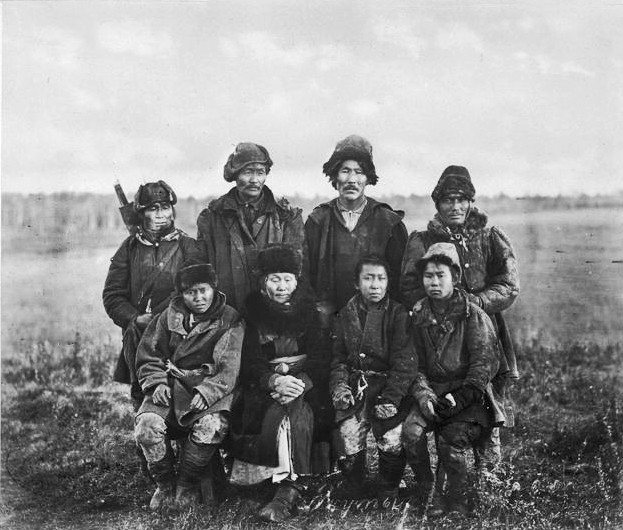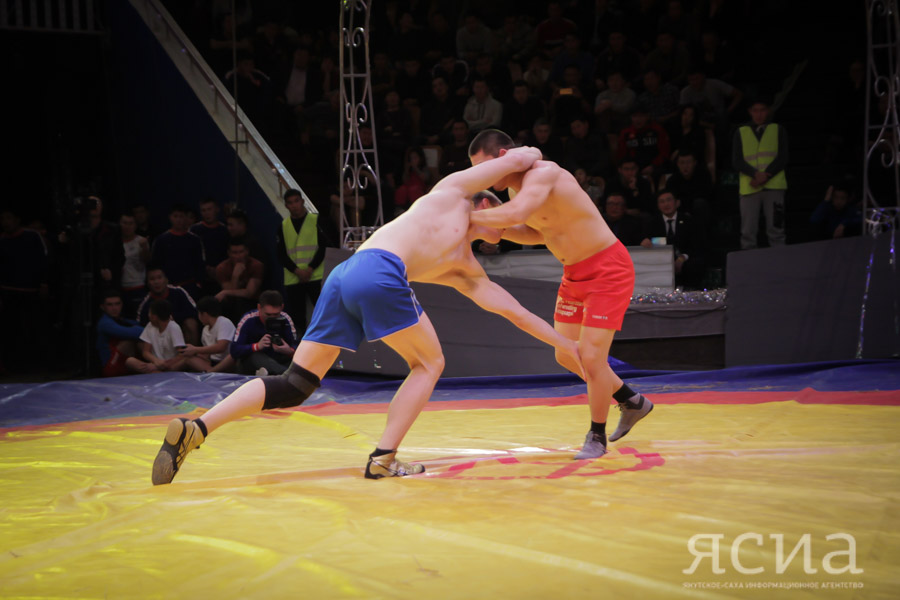Table of Contents
1. Intro
For our first article dedicated to an individual folk wrestling style we decided to look into Khapsagai (Хапсаҕай in native script) the traditional wrestling style of Yakutia (the Sakha Republic). Loosely translated, Хапсаҕай means “agile, dexterous”.
There doesn’t seem to be one single transliteration of the name to the latin alphabet, so across the web you can see it spelled in a variety of ways – Khapsagai, Hapsagai, Khapsagay or Hapsagay. In addition, the plain russian transliteration is Хапсагай. Here, we’ll be spelling it as Khapsagai.
2. Place of origin
The Republic of Sakha (Саха Өрөспүүбүлүкэтэ in the native language), also known as Yakutia, is an automonous part of the Russian federation.
It’s located in the north-eastern part of Siberia, and even though it has a little less than a million inhabitants, it stretches on a piece of land, that’s the size of India, spanning through three time zones.
It is no surprise that with winter temperatures varying between -42 °C and -36 °C (yes, that means between -43°F and -32°F) the settlements here were pronounced some of the coldest inhabited places on earth.
So what kind people live in this harsh land?

The Yakuts actually call themselves Sakha. They are part of the Turkic group of ethnicities. Historically, the main livelihood of the Sakha was hunting and livestock breeding.

In the 13th century, likely because of the rise of the Mongols, they started migrating from the Baikal region to what is now known as Yakutia.
Four centuries later, their paths crossed with another great power – in the 17th century, russian explorers arrived in Yakutia and began to establish their strongholds. Since the fur trade was very strong at that time, they imposed a tax on the locals – a quantity of furs were owed to the Tsardom of Muscovy, based on the count of the cattle each family owned. This set the stage for a series of rebellions. Between the conflicts and epidemics from new diseases, brought by the foreigners, it’s recorded that in the 1640’s the Sakha population around the basin of river Lena fell by around 70%.
Considering the region’s remoteness, Yakutia was recognized early on as a perfect place for forced exile, and many people were sent there on such terms during the Tsarist and Soviet periods.
Even though in 1990 the Yakutian Soviet Socialist Republic declared sovereignty, in 2009 the Supreme Constitutional Court of the Russian Federation sanctioned that most of these provisions be excluded from the Constitution of the Republic of Sakha.
Nowadays, The Republic of Sakha is a very important part of the Russian Federation. And the fur trade is no longer the main reason – in addition to vast gold and diamond mines, it’s said to hold more than 40% of Russia’s coal reserves.
3. Khapsagai in Sakha culture
So far, scholars have failed to pin-point the time when Khapsagai originated. So, many just assume it’s as old as the Sakha people themselves.
There is a period in Sakha history (between the 15th and 16th centuries) called “kyrgys uyete” – “the age of battles and massacre”. At that time, Khapsagai (together with archery, horse riding and other skills) was part of the raising of boys, and they started to train in it from as young as 3 years old.
One of the sources of how Khapsagai used to be practiced in the past are the legends about the great Sakha hero and warrior Tygyn (Тыгын).

Tygyn’s daughter was to marry a Tungus prince. It is told that, Tygyn wrestled several of the Tungus warriors, and even broke 8 ribs of the Tungus prince in one of the matches. Another account tells, that Tygyn pulled one of his opponents’ arms out of it’s socket. So judging by the Sakha folklore, Khapsagai was a very brutal contest once.
In the descriptions, it’s said that before each match, the opponents were covered with moose leather, and their names were kept in secrecy, so you can’t know who you’ll be wrestling until the bout has started.
Usually, no matter what the weather is like, both opponents wrestled shirtless and with shorts, often in a glade.
In the early days, there was no time limit for the matches – they continued until one wrestler won. Speaking of which, the winner was traditionally awarded мюсэ (boiled leg of a stallion) or кымыс (a fermented drink), and a song was performed in his honor.
The audience, however was not so kind to the loser – in some places, they used to all show him their disrespect by performing an obscene gesture…
4. Khapsagai in modern times
Khapsagai started it’s journey on becoming a modern sport during the soviet period. The first Khapsagai national championships were held in 1932 as part of the events for commemorating the 10th year anniversary of forming the Yakutian Autonomous Soviet Socialist Republic.
Since then, competitions have been organized regularly, and a study has even shown that Khapsagai (contrary to many other traditional wrestling styles) has been increasing in popularity nowadays.
Since 2010 Khapsagai has been recognized by FILA (now United World Wrestling).
4.1. What constitutes a victory in Khapsagai?
The objective of Khapsagai is to make the opponent touch the ground with any part of his body above the knee.
The exception to this is planting a hand on the mat, which gets you a penalty. If you try to get out of a tight spot by basing with both your hands, you’ll be declared the loser. This makes matches very dynamic, and oftentimes a clever wrestler can use his opponent’s instinct to sprawl against him.
On top of all that, for a throw to be considered valid, the attacker must land after his opponent has touched the mat (ideally, to remain standing after performing the throw). Also, a takedown is scored only if it began inside the mat circle (even if the one who gets attacked manages to leave the circle before the takedown is finished).
On many occasions famous freestyle wrestlers (and other tough guys) come in as special participants in tournaments, and most confirm that in Khapsagai there is no room for error.
4.2. Garments (uniforms) & Gripping
Today, Khapsagai is practiced shirtless, since grips on the opponent’s garments aren’t used. The uniform in official competitions comprises of shorts and wrestling shoes. It’s also allowed to compete barefoot.
The rules for gripping closely resemble those of freestyle wrestling – it’s allowed to make grips on the opponent’s body, including grabbing the legs. Grabbing (single) fingers is a no go. Grips tend to be shallow – mostly collar ties, grips on the wrists and elbows, with well established clinches being less favored.
4.3. Other general competition rules
As mentioned, the matches traditionally took place on grass, but nowadays modern wrestling mats are used.
Weight classes are somewhat of a new feature. They were first added in 1955. For adult males, they were as follows: 53, 58, 64, 72, 80kg and +80kg.
The match duration is 4 minutes, and if there still isn’t a winner the match continues. Total bout duration is limited to 10 minutes, including the overtimes.
During the soviet period, female divisions were organized as well, so at some point Khapsagai started to be practiced by women too. However we’re not sure about it’s popularity among women today, since we couldn’t find any footage from such divisions in modern tournaments.
4.4. Techniques
The techniques of a grappling style are a reflection its ruleset. Khapsagai is no different. With rules like those, it’s no surprise that there is no groundfighting (ne-waza), and consequently no pins and submissions are trained.
As far as we found out, in Khapsagai techniques are not formally classified as in Judo for example. Reading through our sources, and watching some competition videos, we found out that most throws described in Judo are indeed applied in Khapsagai, albeit with modified grips and setups. It’s an especially big virtue to be able to perform the throws while yourself remaining standing.
But most common seem to be takedowns that utilize leg grabs. Here, Khapsagai is truly unique in that double legs, singles and even high crotch takedowns are modified so that the traditional penetration step from freestyle wrestling is not used (you lose the match if you drop a knee – remember?). A throw utilizing a collar tie and leg grab, called the tyurgen (тюргэн), is widely used. You finish it using the same unbalancing mechanics that are used to finish an ankle pick.

The photo is property of the Yakut-Sakha Information Agency (you can find their full post, along with other photos here). We’re only using it to popularize Khapsagai.
So as to be successful, all the suplex variations, lateral drops and such, are adapted so that the opponent lands first.

The photo is property of the Yakut-Sakha Information Agency (you can find their full post, along with other photos here). We’re only using it to popularize Khapsagai.
Here is a demonstration of Khapsagai techniques:
And here is a highlight footage from competitions the took place in the 2016-2018 period:
5. Influence of Khapsagai on modern grappling
Considering Yakutia’s remoteness, and taking into account that the Sakha people are less than 600 000, you probably wouldn’t expect their wrestling style to have much of an impact on grappling as a whole. However, here are two important points to keep in mind:
- If you’ve been interested in martial arts for a while, you might have heard the ambiguous line that SAMBO (the most famous soviet fighting style) “was created by fusing techniques from Judo, Jiu Jitsu, Catch wrestling, and the national wrestling styles of the peoples of the Soviet Union”. Well, some sources say that Khapsagai may have been among those styles. And in our book, that counts as a major influence on the grappling world.
- Two of the most famous Sakha freestyle wrestlers have trained in Khapsagai as well, and thus have had an influence on that sport:
- Roman Mikhaylovich Dmitriyev – Gold medalist from the 1972 Olympics, held in Munich, and Silver medalist at the 1976 Olympics in Montreal. Medalled multiple times at the Worlds and European Championships.
- Pavel Pinigin – Gold medalist from the 1976 Olympics in Montreal, and 3 times World Champion.
6. Sources
- Khapsagai’s Wikipedia page (in Russian)
- An article by Proshkina V.A., Khoroshikh P.P., Gudkov YU.E., Sergievich A.A. On the question of the history of the yakut national wrestling Khapsagay (in Russian)
- A post titled “Khapsagai: the wrestling style of the strong yakutians” (in Russian)
- A post titled “Khapsagai the yakutian national wrestling style” (in Russian)
- An article about the history and rules of Khapsagai (in Russian)
- An article by Mehmet Türkmen and Nurdin Useev titled “Yakut (Sakha) traditional wrestling with its formation and development: Khapsagay”
- An article by A.V. Cherkashin, N.D. Kronnikov, V.G. Nikitin and N.N. Rozhin titled “National sports combat «Hapsagay» and prospects of its development (united world wrestling)”
- An article by A.A. Gorelov, S.N. Nikitin, V.P. Sushchenko and N.N. Nikiforov titled “Origins and development of Yakut national wrestling hapsagay in domestic combat sports”
- An article about the traditional Sakha games

